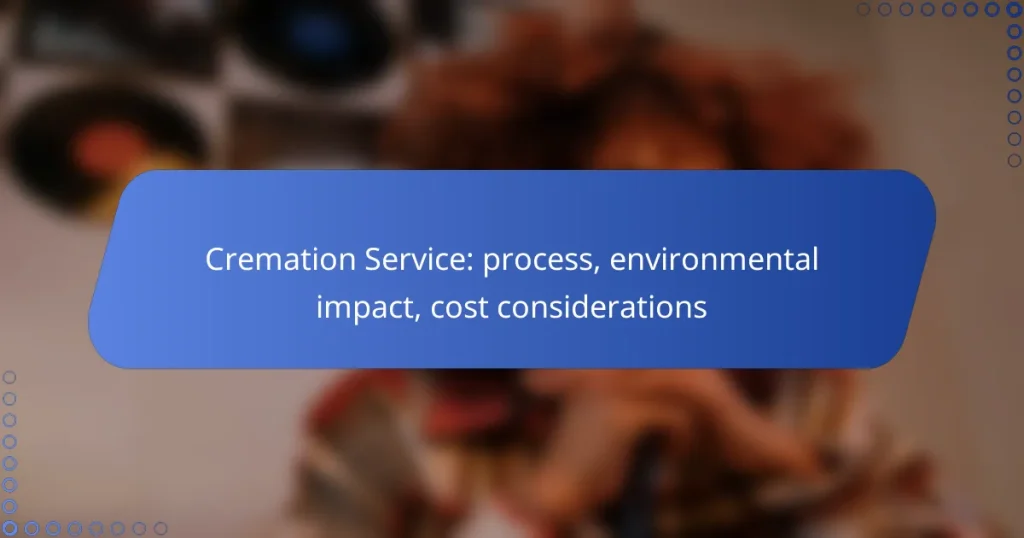Cremation is a popular choice for many families seeking a straightforward and efficient method of handling remains, involving the high-temperature reduction of a body to ashes. While it is often viewed as a more environmentally friendly alternative to traditional burial, it still carries implications for carbon emissions and energy use. The costs for cremation services in Canada can range from CAD 1,000 to CAD 4,000, depending on various factors such as location and specific arrangements.

What is the cremation process in Canada?
The cremation process in Canada involves the reduction of a body to ashes through high-temperature combustion. This method is chosen for its simplicity, efficiency, and often lower environmental impact compared to traditional burial.
Steps involved in cremation
The cremation process typically begins with the preparation of the deceased, which includes obtaining necessary permits and ensuring that the body is free of any materials that could interfere with cremation, such as metal implants. Next, the body is placed in a cremation chamber, where it is exposed to intense heat, usually between 760°C and 1,000°C, for a period of one to three hours.
After the cremation, the remains are processed to create a uniform ash consistency. Families can then choose to keep the ashes in an urn, scatter them in a meaningful location, or inter them in a cemetery. It’s important to communicate preferences with the cremation service provider to ensure that all wishes are respected.
Required documentation for cremation
In Canada, several documents are necessary to proceed with cremation. The most important is the death certificate, which must be issued by a medical professional. Additionally, a cremation authorization form must be signed by the next of kin or legal representative, granting permission for the cremation to take place.
Some provinces may require additional paperwork, such as a burial permit or specific forms related to the handling of remains. It’s advisable to check with the cremation service provider for any local regulations or requirements to avoid delays in the process.

What are the costs associated with cremation services in Canada?
The costs associated with cremation services in Canada can vary significantly based on location, service providers, and specific arrangements. Typically, families can expect to pay anywhere from CAD 1,000 to CAD 4,000 for basic cremation services, with additional fees for memorial services or urns.
Average cremation costs in Ontario
In Ontario, the average cost of cremation services generally falls between CAD 1,500 and CAD 3,000. This range often includes the basic cremation fee, which covers the cremation process itself, and may also encompass transportation of the body and necessary paperwork.
Additional services, such as memorial services or the purchase of an urn, can increase the overall cost. Families should inquire about package deals that may offer savings on combined services.
Factors affecting cremation pricing
Several factors can influence the pricing of cremation services in Canada. Geographic location plays a significant role; urban areas typically have higher costs compared to rural regions. The choice of cremation provider can also affect pricing, as some funeral homes may charge more for their services than others.
Other considerations include the type of cremation selected, such as direct cremation versus a cremation with a memorial service. Optional services, like viewing or additional ceremonies, can further impact the final price.

How does cremation impact the environment?
Cremation has a notable environmental impact, primarily through emissions and energy consumption. While it is often considered more eco-friendly than traditional burial, it still contributes to carbon emissions and requires significant energy for the process.
Carbon footprint of cremation
The carbon footprint of cremation varies depending on the efficiency of the cremation facility and the type of fuel used. On average, a single cremation can produce around 150 to 200 kilograms of CO2 emissions. This is significantly lower than the emissions associated with traditional burial, which can include the production of caskets and the use of land.
To mitigate the carbon footprint, many crematoriums are adopting more energy-efficient technologies and renewable energy sources. Choosing a cremation service that prioritizes sustainability can help reduce overall environmental impact.
Alternative eco-friendly options
For those seeking greener alternatives to traditional cremation, options such as water cremation (alkaline hydrolysis) and natural burial are gaining popularity. Water cremation uses a process involving water and potassium hydroxide, resulting in lower emissions and less energy consumption.
Natural burial allows the body to decompose naturally in a biodegradable casket or shroud, minimizing environmental disruption. Both methods offer a way to honor loved ones while being mindful of ecological footprints.

What should you consider when choosing a cremation service?
When selecting a cremation service, consider factors such as the provider’s reputation, available packages, and overall costs. These elements will help ensure that you choose a service that aligns with your values and budget while meeting your needs during a difficult time.
Reputation of cremation providers
The reputation of cremation providers is crucial for ensuring quality service. Look for reviews and testimonials from previous clients to gauge their experiences. You can also check with local funeral associations or regulatory bodies to verify the provider’s standing and compliance with industry standards.
Consider asking friends or family for recommendations, as personal experiences can provide valuable insights. Additionally, visiting the facility can help you assess cleanliness, professionalism, and overall atmosphere, which are important factors in your decision-making process.
Available cremation packages
Cremation services typically offer various packages that may include different levels of service and pricing. Basic packages often cover the essential elements, such as the cremation itself, while more comprehensive options might include memorial services, urns, and transportation. Understanding what each package entails can help you make an informed choice.
Compare the features of different packages to find one that fits your needs and budget. Some providers may offer customizable options, allowing you to select specific services that are meaningful to you. Always ask for a clear breakdown of costs associated with each package to avoid unexpected expenses.

How do cremation services compare to traditional burial?
Cremation services offer a different approach to handling remains compared to traditional burial. While both methods serve the same purpose, they vary significantly in cost, environmental impact, and space requirements.
Cost comparison between cremation and burial
The cost of cremation is generally lower than that of traditional burial. In the United States, cremation can range from around $1,000 to $3,000, while burial costs often exceed $7,000 when factoring in the casket, plot, and additional services.
When considering cremation, families may save on expenses related to land purchase and maintenance, which are typically associated with burial. However, it’s essential to review the specific services offered by local providers, as prices can vary widely based on location and options selected.
Space and land use considerations
Cremation requires significantly less physical space compared to traditional burial. A single cremation can be accommodated in a small urn, while burial necessitates a plot of land, which can contribute to land use issues in densely populated areas.
Additionally, cremation can alleviate the need for extensive cemetery maintenance and land preservation. This aspect is particularly relevant in urban regions where available land is limited and expensive, making cremation a more practical choice for many families.

What are the legal requirements for cremation in Canada?
In Canada, legal requirements for cremation vary by province but generally include obtaining necessary permits and complying with local regulations. It is essential to understand these requirements to ensure a lawful and respectful cremation process.
Provincial regulations for cremation
Each province in Canada has its own regulations governing cremation. For example, British Columbia requires that cremations be performed by licensed facilities and mandates a waiting period after death. In Ontario, the Funeral, Burial and Cremation Services Act outlines specific guidelines that must be followed, including the need for a death certificate before proceeding with cremation.
It is advisable to consult local authorities or a funeral service provider to understand the specific regulations applicable in your province. This ensures compliance and helps avoid any legal complications during the cremation process.
Necessary permits for cremation
Before cremation can take place, certain permits must be obtained. Typically, a cremation authorization form signed by the next of kin or legal representative is required. Additionally, a death certificate issued by a physician or coroner is often necessary.
In some provinces, a cremation permit issued by the local health authority may also be needed. It is crucial to gather all required documentation ahead of time to prevent delays in the cremation process.

What are the trends in cremation services in Canada?
Cremation services in Canada are increasingly popular, with many families opting for this method due to its affordability and environmental benefits. Recent trends indicate a growing acceptance of cremation, leading to a decline in traditional burials.
Growing Acceptance of Cremation
In Canada, the acceptance of cremation has risen significantly over the past few decades. Many Canadians now view cremation as a respectful and practical choice, often influenced by cultural shifts and changing attitudes toward death and memorialization.
As a result, cremation rates have surpassed traditional burial rates in many provinces, with some areas reporting cremation rates exceeding 75%. This trend reflects a broader societal move towards simpler, more cost-effective end-of-life options.
Environmental Considerations
Cremation is often considered a more environmentally friendly option compared to traditional burials, which require land use and can involve chemical embalming. Many cremation services in Canada are adopting eco-friendly practices, such as using energy-efficient cremation equipment.
Additionally, some facilities offer biodegradable urns or promote scattering ashes in natural settings, aligning with the values of environmentally conscious families. These options allow for a more sustainable approach to memorialization.
Cost Factors
The cost of cremation services in Canada varies widely, typically ranging from a few hundred to several thousand Canadian dollars, depending on the services included. Basic cremation packages often start around CAD 1,000, while more comprehensive services can exceed CAD 3,000.
Families should consider what is included in the package, such as transportation, urn selection, and memorial services. Comparing prices and services from multiple providers can help families find an option that fits their budget and needs.


